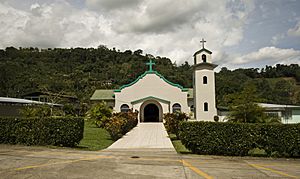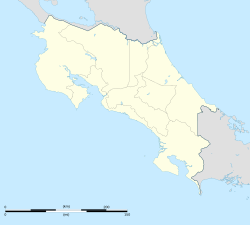Rivas District facts for kids
Quick facts for kids
Rivas
|
|
|---|---|
|
District
|
|

Rivas Church
|
|
| Country | |
| Province | San José |
| Canton | Pérez Zeledón |
| Area | |
| • Total | 310.28 km2 (119.80 sq mi) |
| Elevation | 870 m (2,850 ft) |
| Population
(2011)
|
|
| • Total | 6,591 |
| • Density | 21.2421/km2 (55.017/sq mi) |
| Time zone | UTC−06:00 |
| Postal code |
11904
|
Rivas is a special area called a district in Costa Rica. It's part of the Pérez Zeledón canton, which is like a county. This district is located in the San José province of Costa Rica.
Contents
Geography
Rivas covers an area of about 310 square kilometers. It sits about 870 meters above sea level.
This town is south of the Cordillera de Talamanca mountain range. These mountains formed when two large land plates, the Cocos Plate and the Caribbean Plate, pushed against each other. This pushing caused the land to rise up.
Rivas is located about one kilometer north of where two rivers meet. The Buenavista River and the Chirripó Pacífico River join together. When they combine, they form the General River.
Population
| Historical population | |||
|---|---|---|---|
| Census | Pop. | %± | |
| 1927 | 253 | — | |
| 1950 | 1,547 | 511.5% | |
| 1963 | 2,449 | 58.3% | |
| 1973 | 4,885 | 99.5% | |
| 1984 | 4,977 | 1.9% | |
| 2000 | 6,531 | 31.2% | |
| 2011 | 6,591 | 0.9% | |
|
Instituto Nacional de Estadística y Censos |
|||
In the 2011 census, Rivas had a population of 6,591 people. This number tells us how many people lived there at that time.
Transportation
Road Transportation
The Rivas district has several important roads. These roads help people travel in and out of the area.
Economy
Tourism
Rivas is a popular stop for tourists. It is on the way to the famous Chirripó National Park. Many people visit the park to hike and explore nature.
Archaeology
The Rivas area is an important place for archaeology. This means people study old things found in the ground. They learn about how people lived long ago.
Discovering the Site
In the 1980s, a researcher named Robert Drolet first found the Rivas site. He was doing archaeological surveys, which means looking for signs of ancient life. The Rivas site is one of 15 old places from the Chiriquí Period (AD 750-1500) in this river valley.
Even though farms now cover the area, you can still see signs of old buildings. Many round stone foundations from houses are present. There are also upright boulders, which show that an ancient site is here.
Digging for Clues
In 1992, Jeffrey Quilter from the Peabody Museum of Archaeology and Ethnology began digging at Rivas. His team found structures similar to those found at another site called Murciélago, Costa Rica.
Over six years, Quilter's team found several areas where people used to live. The houses were built using river cobbles arranged in circles. These circles were different sizes, from 10 meters to 30 meters across. Many houses also had rectangular patios next to them. The team also found old paths, walkways, open areas (plazas), and stairways.
It's not fully clear what these structures were used for. Most broken pieces of ceramic pots were found outside these buildings. Very few were found inside. This suggests that people swept their trash pottery out of their living areas.
Ancient Burials
Old cemeteries from the Chiriquí period were found near the site. These burial grounds might have belonged to specific groups of people in Rivas. The graves did not follow a clear pattern. They were marked by carefully placed river cobbles in a special area.
The items found in the graves, called grave goods, showed differences. Some graves had more or better quality items. This might mean that some people had a higher social status than others. None of the graves contained gold or tumbaga (a gold and copper mix) artifacts.
A Special Area
Researchers also found a separate area that might have been used for ceremonies. At first, they thought it was another cemetery because of the stone piles that looked like tombs. But digging showed it was not a burial ground or a living area.
A nearby staircase might have connected this area to a place called Panteón de La Reina on a ridge above. Scientists believe this special area was used for rituals. These rituals might have been performed before people were buried on the ridge.
What They Found
Over 600,000 broken pieces of ceramic pots were found at the Rivas site. The research team focused on special pieces like rims and decorated parts. They found that 60% of the rims and 72% of other pieces were decorated in the Buenos Aires Polychrome style. This type of pottery was often used for celebrations during the Chiriquí Period.
The second most common pottery style was called Red Wares. This included Sangria Red Fine and Turucaca White-On-Red styles.
The team also found 8,632 stone tools. Most of these tools were made from andesite and basalt, which are types of rock. Almost all of them were chipped stone tools, like endscrapers and perforators. These tools were used for scraping and making holes.
They rarely found ground stone tools. These included one adze (a cutting tool), 8 celts (like small axes), and broken pieces of manos and metates. Manos and metates were stones used to grind corn or other foods.
Several small clay figures were also found. They were solid and no taller than 7 cm. These figures usually showed women sitting with their legs out. Often, their heads were broken off.
The excavations also uncovered ceramic musical instruments. One large broken rattle was found in a cemetery. It was shaped like a squash blossom. A ceramic bead was inside it to make noise when shaken. Two ceramic whistles were also found. One whistle looked like a human head and was probably worn around the neck. The other whistle was shaped like a bird with folded wings.
See also
 In Spanish: Rivas (Costa Rica) para niños
In Spanish: Rivas (Costa Rica) para niños


